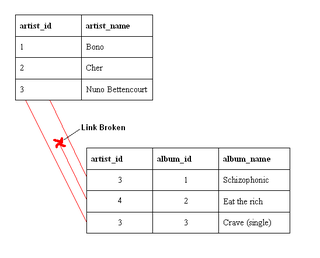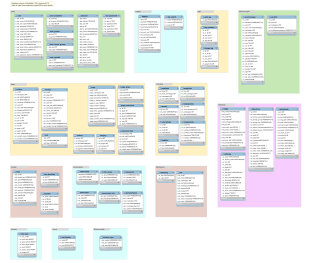Database normalization is the process of structuring a relational database in accordance with a series of so-called normal forms in order to reduce data redundancy and improve data integrity. It was first proposed by British computer scientist Edgar F. Codd as part of his relational model.
A relational database is a database based on the relational model of data, as proposed by E. F. Codd in 1970. A database management system used to maintain relational databases is a relational database management system (RDBMS). Many relational database systems are equipped with the option of using SQL for querying and updating the database.
The relational model (RM) is an approach to managing data using a structure and language consistent with first-order predicate logic, first described in 1969 by English computer scientist Edgar F. Codd, where all data is represented in terms of tuples, grouped into relations. A database organized in terms of the relational model is a relational database.
Data integrity is the maintenance of, and the assurance of, data accuracy and consistency over its entire life-cycle. It is a critical aspect to the design, implementation, and usage of any system that stores, processes, or retrieves data. The term is broad in scope and may have widely different meanings depending on the specific context even under the same general umbrella of computing. It is at times used as a proxy term for data quality, while data validation is a prerequisite for data integrity.
First normal form (1NF) is a property of a relation in a relational database. A relation is in first normal form if and only if no attribute domain has relations as elements. Or more informally, that no table column can have tables as values. Database normalization is the process of representing a database in terms of relations in standard normal forms, where first normal is a minimal requirement. SQL-92 does not support creating or using table-valued columns, which means that using only the "traditional relational database features" most relational databases will be in first normal form by necessity. Database systems which do not require first normal form are often called NoSQL systems. Newer SQL standards like SQL:1999 have started to allow so called non-atomic types, which include composite types. Even newer versions like SQL:2016 allow JSON.

In computing, extract, transform, load (ETL) is a three-phase process where data is extracted from an input source, transformed, and loaded into an output data container. The data can be collated from one or more sources and it can also be output to one or more destinations. ETL processing is typically executed using software applications but it can also be done manually by system operators. ETL software typically automates the entire process and can be run manually or on reccurring schedules either as single jobs or aggregated into a batch of jobs.
In the relational model of databases, a primary key is a specific choice of a minimal set of attributes (columns) that uniquely specify a tuple (row) in a relation (table). Informally, a primary key is "which attributes identify a record," and in simple cases constitute a single attribute: a unique ID. More formally, a primary key is a choice of candidate key ; any other candidate key is an alternate key.
A foreign key is a set of attributes in a table that refers to the primary key of another table, linking these two tables. In the context of relational databases, a foreign key is subject to a inclusion dependency constraint that the tuples consisting of the foreign key attributes in one relation, R, must also exist in some other relation, S; furthermore that those attributes must also be a candidate key in S.

Referential integrity is a property of data stating that all its references are valid. In the context of relational databases, it requires that if a value of one attribute (column) of a relation (table) references a value of another attribute, then the referenced value must exist.
In the context of SQL, data definition or data description language (DDL) is a syntax for creating and modifying database objects such as tables, indices, and users. DDL statements are similar to a computer programming language for defining data structures, especially database schemas. Common examples of DDL statements include CREATE, ALTER, and DROP.
A surrogate key in a database is a unique identifier for either an entity in the modeled world or an object in the database. The surrogate key is not derived from application data, unlike a natural key.
Database design is the organization of data according to a database model. The designer determines what data must be stored and how the data elements interrelate. With this information, they can begin to fit the data to the database model. A database management system manages the data accordingly.

In SQL, null or NULL is a special marker used to indicate that a data value does not exist in the database. Introduced by the creator of the relational database model, E. F. Codd, SQL null serves to fulfil the requirement that all true relational database management systems (RDBMS) support a representation of "missing information and inapplicable information". Codd also introduced the use of the lowercase Greek omega (ω) symbol to represent null in database theory. In SQL, NULL is a reserved word used to identify this marker.
A check constraint is a type of integrity constraint in SQL which specifies a requirement that must be met by each row in a database table. The constraint must be a predicate. It can refer to a single column, or multiple columns of the table. The result of the predicate can be either TRUE, FALSE, or UNKNOWN, depending on the presence of NULLs. If the predicate evaluates to UNKNOWN, then the constraint is not violated and the row can be inserted or updated in the table. This is contrary to predicates in WHERE clauses in SELECT or UPDATE statements.
Data cleansing or data cleaning is the process of detecting and correcting corrupt or inaccurate records from a record set, table, or database and refers to identifying incomplete, incorrect, inaccurate or irrelevant parts of the data and then replacing, modifying, or deleting the dirty or coarse data. Data cleansing may be performed interactively with data wrangling tools, or as batch processing through scripting or a data quality firewall.
A slowly changing dimension (SCD) in data management and data warehousing is a dimension which contains relatively static data which can change slowly but unpredictably, rather than according to a regular schedule. Some examples of typical slowly changing dimensions are entities such as names of geographical locations, customers, or products.
An entity–attribute–value model (EAV) is a data model optimized for the space-efficient storage of sparse—or ad-hoc—property or data values, intended for situations where runtime usage patterns are arbitrary, subject to user variation, or otherwise unforeseeable using a fixed design. The use-case targets applications which offer a large or rich system of defined property types, which are in turn appropriate to a wide set of entities, but where typically only a small, specific selection of these are instantiated for a given entity. Therefore, this type of data model relates to the mathematical notion of a sparse matrix. EAV is also known as object–attribute–value model, vertical database model, and open schema.
In relational database management systems, a unique key is a candidate key. All the candidate keys of a relation can uniquely identify the records of the relation, but only one of them is used as the primary key of the relation. The remaining candidate keys are called unique keys because they can uniquely identify a record in a relation. Unique keys can consist of multiple columns. Unique keys are also called alternate keys. Unique keys are an alternative to the primary key of the relation. In SQL, the unique keys have a UNIQUE constraint assigned to them in order to prevent duplicates. Alternate keys may be used like the primary key when doing a single-table select or when filtering in a where clause, but are not typically used to join multiple tables.

A database model is a type of data model that determines the logical structure of a database. It fundamentally determines in which manner data can be stored, organized and manipulated. The most popular example of a database model is the relational model, which uses a table-based format.
The syntax of the SQL programming language is defined and maintained by ISO/IEC SC 32 as part of ISO/IEC 9075. This standard is not freely available. Despite the existence of the standard, SQL code is not completely portable among different database systems without adjustments.



